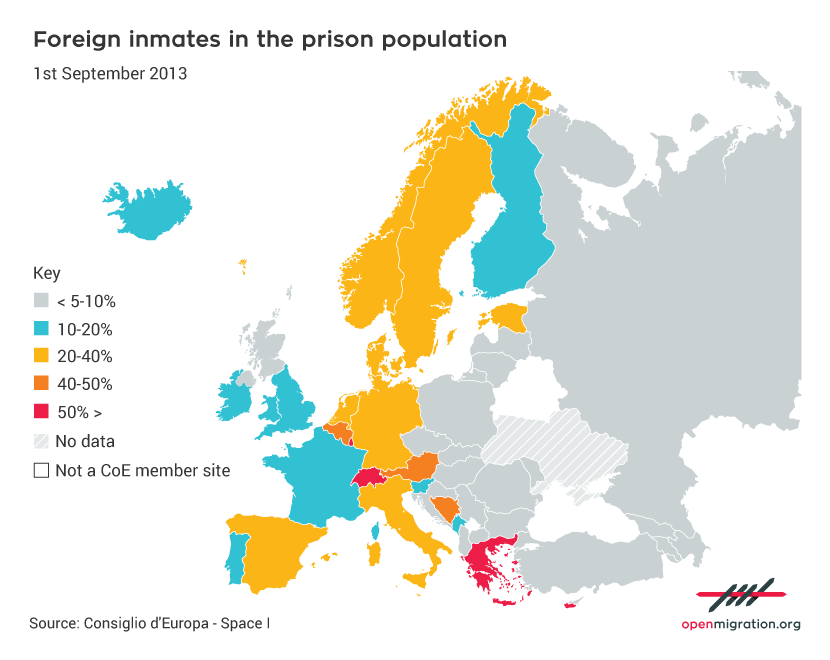Rattling off the numbers evidencing the size of a phenomenon. Immigrants account for the 21% of prisoners in Europe, surprise for Switzerland, Italy and the case of foreign pre-trial detainees.
In its reports Space I and Space II, the University of Lausanne collected the most recent data on the prison situation and on alternative measures to detention in Europe, from the Atlantic Ocean to the Urals. It has to be preliminarily acknowledged that it is not an easy task to organize information from 47 Countries, many of which do not keep official statistical records of prison data or answer academic solicitations – although supported by the Council of Europe – with significant delay. This explains why prison statistical data in Europe date to 2012 while in Italy, for instance, they are available almost in real time.
Europe has about 800 million inhabitants. Detainees in European prisons are only one million and 700 thousand or, to be specific one million and 737 thousand. There are about 100 thousand detainees less than last year. The average incarceration rate is of about 150 detainees for 100 thousand inhabitants. Between 2011 and 2012 in a limited, but significant, number of Countries there was a decrease in the percentage of the prisoned population of more than 5%; among those Countries there were the Russian Federation, Spain, Turkey and Sweden. But also England, Germany and the Netherlands, although less significant, recorded a decrease in the percentage of the prisoned population that countered long previous periods of growth. Between 2012 and 2015, also Italy registered a decrease both in absolute and in percentage terms.
Immigrants behind bars
How much do foreigners account for with respect to the incarceration rate and the overcrowding of prisons as opposed to national citizens? The average presence of immigrants in the European penitentiary system is 21%. Slightly more than a detainee out of five was not issued a passport from the State which holds him behind bars. Lower rates are found, unsurprisingly, in Eastern Countries that are traditionally Countries of emigration rather than of immigration. The highest rates are registered, on the contrary, in some Central European Countries (Belgium and Austria, for instance).
In Romania, foreign detainees are few, that is 0.6% of the total amount. In Albania, non-Albanian detainees are 1.8%. In Turkey, non-Turkish detainees account for 1.7%. In Switzerland, on the contrary, the non-Swiss prisoned population accounts for 74.3%. This is an impressive number, largely justified by the traditional protectionism of Swiss borders. More specifically, among the 4,896 foreign detainees in Switzerland (in part Italians), only 1,330 have a valid residency permit and 716 have the status of asylum seekers. The others are illegal immigrants. Generally, the criminal rate among immigrants in possess of a valid residency permit is low, not only in Switzerland.

Integration represents a fundamental chance in exchange for the respect of social conduct rules. Percentages of foreign detainees (excluding Andorra, Cyprus, Liechtenstein, Luxembourg and the Principality of Monaco where overall data on incarceration are not representative, being those small Countries) above 40%, as mentioned, are recorded in Austria, with 46.7% rate, and in Belgium, with 42.3% rate.
France and England, both having large immigrants’ communities, show lower rates of foreign detainees, 17.9% and 12.6%, respectively. The explanation is double: on one hand, citizenship is more accessible for those coming from former colonies; on the other hand, legislation on asylum is more flexible, so that the risk of creating a vicious circle which starts with illegal immigration and results in criminal behaviors is reduced.
The situation in Italy
In Italy, foreign detainees are 32% (as of 2015) of the total amount, that is a result of 11 percentage points above of the European average. Almost 4 percentage points above Germany, which has one of the lowest overcrowding ratios of the European Union, well below the ratio of 100 detainees for 100 beds.
In Italy, legal immigrants are about 8% of the total population. Foreign detainees are 32% of the total. Legal immigrants, according to random inspections in single penitentiaries, are less than 10% of the total foreign detainees’ population, that is about 3% of the total prisoned population in our Country. This is a lower percentage as compared to that of Italian prisoners.
Foreign detainees imprisoned notwithstanding the absence of a final conviction are 37.9% of the total population. More than a foreign detainee out of 3 (almost 2 out of 5) is imprisoned although is not guilty according to the Italian justice.
Pre-trial detention
The average weight of pre-trial detention for domestic detainees is about 25%, that is 12% less than foreign detainees. In total, detainees imprisoned while in wait of final judgment are not one out of 3, as with respect to foreign detainees, but one out of 4.
Therefore, justice tends to discriminate against foreigners: pre-trial detention is more easily applied to foreigners and becomes for them a sort of anticipated punishment. Looking at data relating to single European States, the range is from 10.4% of Azerbaijan to 75.6% of Bosnia Herzegovina. It is worth noting what happens in Countries with a low rate of pre-trial detention. Such rates are actually low with respect to national citizens, but turn out to be very high with respect to foreigners: 50.6% of foreign detainees in Sweden are pre-trial detainees, as 53.3% in Norway and in the Netherlands, and 57.2% in Denmark.

The average percentage of foreign pre-trial detainees as opposed to the overall prisoned population waiting for judgment is 28%, against 21% of their total representations (which includes convicted detainees).
In Italy, the percentage of foreign pre-trial detainees is somewhat in line with the European figure. But Italy is the Country where pre-trial detention traditionally accounts for more than in other European Countries, that ratio being now about 31.1%, and reaching only a few years ago almost 50%.
Immigrants are more frequently subject to pre-trial detention orders as opposed to national detainees. The over-representation of immigrants among those imprisoned before final judgment is the symptom of a judicial system that discriminates on the basis of race. With respect to illegal immigrants it is definitely difficult to envisage pre-trial solutions other than detention. Judges often justify pre-trial detention arguing that illegal immigrants do not have a domicile where they can be put under arrest. The truth is that illegal immigrants do have a house or a room where they live, but such accommodations cannot be considered as domicile because of their often general condition as outlaws.

Immigration mechanisms grounded on the forecast and regulation of immigration streams, that is the approach of the majority of western Countries’ legislations, deny citizenship rights (i.e., the right to vote, to work, and to a home) to those who enter the Country illegally. Therefore, illegal immigrants will end up in pre-trial detention more easily than other legal immigrants. As a result, immigration laws directly affect imprisonment rates. The same happens with respect to alternative measures to pre-trial detention that are grounded on requirements of legal housing conditions. In terms of percentage, the number of alternative measures granted is lower for illegal foreign detainees than for national detainees.
Information on the presence of extra-European detainees must also take into account, beside the negative impact of alternative measures to pre-trial detention grounded on requirements of legal housing, the fact that extra-European Countries enter less frequently into international agreements providing for the extradition or transfer of persons convicted for a crime. In the absence of those agreements, the judiciary feels entitled to maintain foreign detainees imprisoned, mistrusting alternative measures.
How much do EU immigrants account for?
How much do EU citizens account for in the share of foreign detainees? That is, how many foreign detainees in Europe come from the EU area? 32.4%. This number is in line with the German data, affected by the weight of Polish, Croatian and Rumanian immigration, and with the English data, less subject to immigration from Southern Mediterranean Countries. The incidence of EU citizenship is lower in Italy or Spain, where the percentage of European detainees accounts for only 20%.
Considering that foreign detainees incarcerated in the 47 Countries of the Council of Europe are about 370 thousand, and also considering that EU detainees are about 120 thousand, it results that extra-European detainees within the European jurisdiction are about 250 thousand. Overall, they represent 14% of total prisoned population. They are few, considering the media and political coverage of such phenomenon, as well as too many, considering the low rates of crimes against the person for which they are responsible and to the similarly low rates of adhesion to criminal or terroristic organizations, or to the mafia.
It would be sufficient for national legislations to be more elastic in granting assistance to immigrants as well as the possibility to obtain citizenship to avoid the occurrence of social and judicial conditions that foster the resort to detention and, especially, to pre-trial detention. In any case, notwithstanding the strong anti-immigrants imaginary typical of several Countries, the difficult social conditions that immigrants face because of the ongoing processes of marginalization and stigmatization, and their impaired availability to resort to legal assistance, numbers of foreign criminals are not high enough to justify an alarm for national security. Foreign criminality is not the political or judicial urgency of Europe. The numbers are not sufficient to support xenophobic campaigns. At most, they reveal a discriminatory judicial system.










